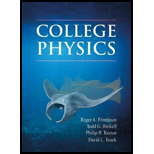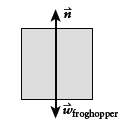
Concept explainers
(a)
The time of the jump and acceleration during the time.
Answer to Problem 91QAP
The time of the jump is
Explanation of Solution
Givendata:
Distance, for take-off speed
Distance for acceleration necessary to attain the required speed from rest
Final speed
Initial speed
Formula Used:
Newton's second law:
Calculation:
We are interested in the portionof the jump while the insect is still on the ground.
We can assume that the acceleration of theinsect is constant during this phase
In order to calculate the acceleration of the insect and thelength of time during this phase of the jump, we first need to calculate the speed with whichthe froghopper leaves the ground.
While the insect is in the air, it is only under the influenceof gravity, so we can use the constant acceleration equations and the height of the jump tocalculate the takeoff speed.
Once we have this value, we know the froghopper acceleratedfrom rest through a distance of
The forces acting on the insectwhile it is on the ground are the force of the ground on the froghopper pointing up (that is,the normal force) and the force of gravity pointing down.
After defining a coordinate systemwhere positive y points upward, we can calculate the magnitude of the normal force usingNewton's second law.
Takeoff speed is,
Acceleration necessary to attain that speed from rest is,
Time is,
Conclusion:
The time of the froghopper jump is
(b)
The free body diagram of the grasshopper during the leap.
Explanation of Solution
Free body diagram of the grasshopper during the leap is,

Where,
(c)
The force that ground exert on the froghopper during the jump in millinewtons and represent it as a multiple of insect's weight.
Answer to Problem 91QAP
The force that ground exert on the froghopper during the jump in millinewtons is
And the force
Explanation of Solution
Given data:
Distance, for take-off speed
Distance for acceleration necessary to attain the required speed from rest
Final speed
Initial speed
Formula Used:
Newton's second law:
Calculation:
We are interested in the portionof the jump while the insect is still on the ground.
We can assume that the acceleration of the insect is constant during this phase
In order to calculate the acceleration of the insect and the length of time during this phase of the jump. We first need to calculate the speed with which the froghopper leaves the ground.
While the insect is in the air, it is only under the influence of gravity, so we can use the constant acceleration equations and the height of the jump to calculate the takeoff speed.
Once we have this value, we know the froghopper accelerated from rest through a distance of
We can directly calculate the time because we are assuming the acceleration is constant.
The forces acting on the insect while it is on the ground are the force of the ground on the froghopper pointing up (that is, the normal force) and the force of gravity pointing down.
After defining a coordinate system where positive y points upward, we can calculate the magnitude of the normal force using Newton's second law.
froghopper's weight
This force is
Conclusion:
Thus, we have the value of force
And the force is
Want to see more full solutions like this?
Chapter 4 Solutions
COLLEGE PHYSICS
- 2) If Mand N be two water hyper Plane ofx Show that MUN and MN is hy Per Plane ofx with prove and Examplame. or 3) IS AUB is convex set and affine set or blensed set or symmetre setorsubsie.... Show that A and B is convex or affine or Hensedsed or symmetivce or subspace. 4) 18 MUN is independence show that Prove or ExPlane Mand Nave independend. or not. 5) Jet X be Vector Pace over I show that is xty tnx st Xty 3 fix→ F s-t f(x) (9) Jet Mand N be two blanced set of Xbe Vector space show tha MUNIS ansed setarrow_forwardFind a polynomial with integer coefficients that satisfies the given conditions. T(x) has degree 4, zeros i and 1 + i, and constant term 12.arrow_forwardHow to solve 2542000/64132 without a calculator?arrow_forward
- How much is the circumference of a circle whose diameter is 7 feet?C =π darrow_forwardHow to solve 2542/64.132arrow_forwardAssume that you fancy polynomial splines, while you actually need ƒ(t) = e²/3 – 1 for t€ [−1, 1]. See the figure for a plot of f(t). Your goal is to approximate f(t) with an inter- polating polynomial spline of degree d that is given as sa(t) = • Σk=0 Pd,k bd,k(t) so that sd(tk) = = Pd,k for tk = −1 + 2 (given d > 0) with basis functions bd,k(t) = Σi±0 Cd,k,i = • The special case of d 0 is trivial: the only basis function b0,0 (t) is constant 1 and so(t) is thus constant po,0 for all t = [−1, 1]. ...9 The d+1 basis functions bd,k (t) form a ba- sis Bd {ba,o(t), ba,1(t), bd,d(t)} of the function space of all possible sα (t) functions. Clearly, you wish to find out, which of them given a particular maximal degree d is the best-possible approximation of f(t) in the least- squares sense. _ 1 0.9 0.8 0.7 0.6 0.5 0.4 0.3 0.2 0.1 0 -0.1 -0.2 -0.3 -0.4 -0.5 -0.6 -0.7 -0.8 -0.9 -1 function f(t) = exp((2t)/3) - 1 to project -1 -0.9 -0.8 -0.7 -0.6 -0.5 -0.4 -0.3 -0.2 -0.1 0 0.1 0.2 0.3 0.4 0.5…arrow_forward
- An image processor considered a 750×750 pixels large subset of an image and converted it into gray-scale, resulting in matrix gIn - a false-color visualization of gIn is shown in the top-left below. He prepared a two-dim. box filter f1 as a 25×25 matrix with only the 5×5 values in the middle being non-zero – this filter is shown in the top-middle position below. He then convolved £1 with itself to get £2, before convolving £2 with itself to get f3. In both of the steps, he maintained the 25×25 size. Next, he convolved gIn with £3 to get gl. Which of the six panels below shows g1? Argue by explaining all the steps, so far: What did the image processor do when preparing ₤3? What image processing operation (from gin to g1) did he prepare and what's the effect that can be seen? Next, he convolved the rows of f3 with filter 1/2 (-1, 8, 0, -8, 1) to get f4 - you find a visualization of filter f 4 below. He then convolved gIn with f4 to get g2 and you can find the result shown below. What…arrow_forward3ur Colors are enchanting and elusive. A multitude of color systems has been proposed over a three-digits number of years - maybe more than the number of purposes that they serve... - Everyone knows the additive RGB color system – we usually serve light-emitting IT components like monitors with colors in that system. Here, we use c = (r, g, b) RGB with r, g, bЄ [0,1] to describe a color c. = T For printing, however, we usually use the subtractive CMY color system. The same color c becomes c = (c, m, y) CMY (1-c, 1-m, 1-y) RGB Note how we use subscripts to indicate with coordinate system the coordinates correspond to. Explain, why it is not possible to find a linear transformation between RGB and CMY coordinates. Farbenlehr c von Goethe Erster Band. Roſt einen Defte mit fergen up Tübingen, is et 3. Cotta'fden Babarblung. ISIO Homogeneous coordinates give us a work-around: If we specify colors in 4D, instead, with the 4th coordinate being the homogeneous coordinate h so that every actual…arrow_forwardCan someone provide an answer & detailed explanation please? Thank you kindly!arrow_forward
- Given the cubic function f(x) = x^3-6x^2 + 11x- 6, do the following: Plot the graph of the function. Find the critical points and determine whether each is a local minimum, local maximum, or a saddle point. Find the inflection point(s) (if any).Identify the intervals where the function is increasing and decreasing. Determine the end behavior of the graph.arrow_forwardGiven the quadratic function f(x) = x^2-4x+3, plot the graph of the function and find the following: The vertex of the parabola .The x-intercepts (if any). The y-intercept. Create graph also before solve.arrow_forwardwhat model best fits this dataarrow_forward
- Algebra & Trigonometry with Analytic GeometryAlgebraISBN:9781133382119Author:SwokowskiPublisher:Cengage
 Trigonometry (MindTap Course List)TrigonometryISBN:9781337278461Author:Ron LarsonPublisher:Cengage Learning
Trigonometry (MindTap Course List)TrigonometryISBN:9781337278461Author:Ron LarsonPublisher:Cengage Learning Algebra and Trigonometry (MindTap Course List)AlgebraISBN:9781305071742Author:James Stewart, Lothar Redlin, Saleem WatsonPublisher:Cengage Learning
Algebra and Trigonometry (MindTap Course List)AlgebraISBN:9781305071742Author:James Stewart, Lothar Redlin, Saleem WatsonPublisher:Cengage Learning


